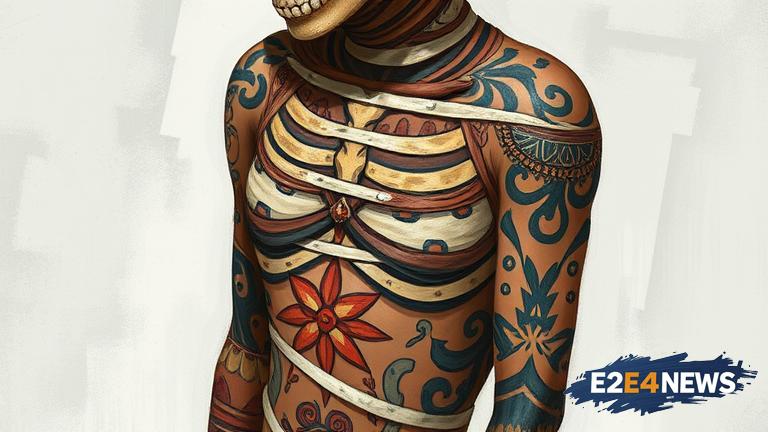The discovery of the Ice Mummy, Ötzi, in 1991 sent shockwaves through the archaeological community, and recent studies have shed new light on the significance of his tattoos. Ötzi, who lived around 3300 BC, was found with a total of 61 tattoos, including parallel lines, shapes, and even a cross on his knee. These tattoos are not only remarkable for their age but also for the level of sophistication and artistry they display. Researchers believe that the tattoos may have been used for therapeutic purposes, such as relieving pain or inflammation, as many of the tattoos are located near joints and areas of the body that are prone to injury. The tattoos may have also held spiritual or cultural significance, as they are similar to those found on other ancient civilizations. The use of tattoos as a form of expression and identification is not unique to modern times, as evidenced by Ötzi’s impressive collection. In fact, the practice of tattooing dates back thousands of years, with evidence of tattoos found on mummies from ancient Egypt, China, and other cultures. The discovery of Ötzi’s tattoos has sparked a renewed interest in the history of tattooing, with many researchers seeking to learn more about the techniques and materials used by ancient civilizations. The study of Ötzi’s tattoos has also provided valuable insights into the lives of ancient people, including their social status, occupation, and cultural practices. For example, the presence of tattoos on Ötzi’s body suggests that he may have held a high social status or been a member of a particular group or tribe. The tattoos may have also been used to signify his occupation or role in society, such as a warrior or spiritual leader. Furthermore, the discovery of Ötzi’s tattoos has raised questions about the origins of tattooing and how it spread across different cultures. Researchers believe that tattooing may have originated in the Middle East or Asia, where it was practiced by ancient civilizations such as the Egyptians and Chinese. From there, it may have spread to other parts of the world, including Europe, where it was adopted by various cultures. The study of Ötzi’s tattoos has also highlighted the importance of preserving cultural heritage and the need to protect ancient artifacts from damage or destruction. The Ice Mummy, Ötzi, is now housed in a special museum in Italy, where it is preserved in a controlled environment to prevent deterioration. The museum has become a popular tourist destination, attracting visitors from around the world who are fascinated by the history and significance of the Ice Mummy. In addition to the tattoos, Ötzi’s body has provided a wealth of information about the lives of ancient people, including their diet, health, and lifestyle. For example, analysis of Ötzi’s stomach contents has revealed that he ate a diet rich in meat and bread, while his body has shown signs of wear and tear, suggesting that he engaged in physically demanding activities. The study of Ötzi’s body has also provided insights into the medical practices of ancient civilizations, including the use of herbal remedies and other forms of treatment. Overall, the discovery of Ötzi’s tattoos has opened up new avenues of research into the history of tattooing and the lives of ancient civilizations. As researchers continue to study the Ice Mummy and his tattoos, they are gaining a deeper understanding of the cultural, social, and spiritual practices of ancient people, and how these practices have evolved over time. The significance of Ötzi’s tattoos extends beyond their historical importance, as they also provide a unique window into the lives of ancient people and their cultural practices. The study of Ötzi’s tattoos has also highlighted the importance of interdisciplinary research, as scholars from various fields, including archaeology, anthropology, and history, come together to study and interpret the findings. By combining their expertise, researchers are able to gain a more comprehensive understanding of the significance of Ötzi’s tattoos and their place in the broader context of human history. In conclusion, the discovery of Ötzi’s tattoos has been a major breakthrough in the field of archaeology, providing new insights into the lives of ancient civilizations and the history of tattooing. As researchers continue to study the Ice Mummy and his tattoos, they are uncovering new secrets about the past and shedding light on the cultural, social, and spiritual practices of ancient people.





